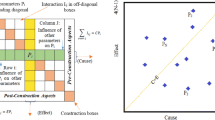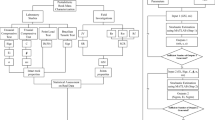Abstract
Mining methods such as block caving or sublevel caving rely on the characteristics of the rock mass to cave efficiently to fulfill an economical production. The identification of influencing parameters and cavability assessment are, thus, a prime geotechnical focus for all potential caving projects. In the caving operation, many factors, such as natural and induced factors, affect the caving performance. In this study, after discussing the caving process and identifying all effective parameters, the interaction matrix based on the rock engineering system (RES) is introduced to study the influencing parameters in rock mass cavability. The interaction matrix analyzes the interrelationship between the parameters affecting rock engineering activities. As the interaction matrix codes are not unique, probabilistic coding can be performed non-deterministically, allowing consideration of uncertainties in the RES analysis. As a result, the parameters with the highest probability of being dominant or subordinate, and also the parameters with the highest probability of being interactive, are introduced. The proposed approach could be a simple but efficient tool in the evaluation of the parameters affecting the cavability of rock mass in block caving mines and, hence, useful in decision-making under uncertainties.
















Similar content being viewed by others
References
Brady BHG, Brown ET (2004) Rock mechanics for underground mining. Springer, New York
Brown ET (2007) Block caving geomechanics. International Caving Study 1997–2004. Julius Kruttschnitt Mineral Research Centre, The University of Queensland
Budetta P, Santo A, Vivenzio F (2008) Landslide hazard mapping along the coastline of the Cilento region (Italy) by means of a GIS-based parameter rating approach. Geomorphology 94(3):340–352
Butcher RJ (2000) Block cave undercutting—aims, strategies, methods and management. Proc MassMin 2000:405–411
Diering JAC, Laubscher DH (1987) Practical approach to the numerical stress analysis of mass mining operations. Institution of Mining and Metallurgy Transactions, Section A: Mining Industry, vol 96
Heslop TG, Laubscher DH (1981) Draw control in caving operations on Southern African chrysotile asbestos mines. Design and operation of caving and sublevel stoping mines, pp 775–774
Hudson JA (1992) Rock engineering systems, theory and practice. Ellis Horwood, Chichester
Hudson JA, Harrison JP (1992) A new approach to studying complete rock engineering problems. Quart J Eng Geol Hydrogeol 25(2):93–105
Jiao Y, Hudson JA (1995) The fully-coupled model for rock engineering systems. Int J Rock Mech Min Sci Geomech Abs 32:491–512
Jiao Y, Hudson JA (1998) Identifying the critical mechanisms for rock engineering design. Geotechnique 48(3):319–335
Julian DE (1974) Future developments in block caving. Skillings Mining Review, pp 12–15
Kendorski FS (1978) Cavability of ore deposits. Min Eng 30:628-631
Laubscher DH (1990) A geomechanics classification system for the rating of rock mass in mine design. J S Afr Inst Metall 90(10):267–273
Laubscher DH (1994) Cave mining—the state of the art. J S Afr Inst Min Metall 94(10):2279
Laubscher D (2000a) A practical guide manual on block caving. International Caving Study (1997–2000). Capitulo, pp 1–3
Laubscher DH (2000b) A practical manual on block caving. Julius Kruttschnitt Mineral Research Centre, Brisbane
Laubscher DH (2003) Cave mining handbook. De Beers, Johannesburg
Lorig LJ, Board MP, Potyondy DO, Coetzee MJ (1995) Numerical modelling of caving using continuum and micro-mechanical models. In: Proceedings of CAMr95: 3rd Canadian conference on computer applications in the minerals Industry, Montreal, Quebec, Canada, October 1995
Mahtab MA, Dixon JD (1976) Influence of rock fractures and block boundary weakening on cavability. Trans Soc Min Eng AIME 260:6–12
Mawdesley C (2002) Predicting rock mass cavability in block caving mines. Ph.D. thesis, University of Queensland
Mawdesley C, Trueman R, Whiten W (2001) Extending the Mathews stability graph for open-stope design. Transactions of the Institution of Mining and Metallurgy, Mining Technology, Section A, pp 27–39
Obert L, Munson R, Rich C (1976) Caving properties of the Climax ore body. Trans Soc Min Eng AIME 260:129–133
Rozos D, Pyrgiotis L, Skias S, Tsagaratos P (2008) An implementation of rock engineering system for ranking the instability potential of natural slopes in Greek territory. An application in Karditsa County. Landslides 5(3):261–270
Sainsbury B-A (2012) A model for cave propagation and subsidence assessment in jointed rock masses. Doctoral dissertation, the University of New South Wales
Shang YJ, Wang SJ, Li GC, Yang ZF (2000) Retrospective case example using a comprehensive suitability index (CSI) for siting the Shisan-Ling power station, China. Int J Rock Mech Min Sci 37(5):839–853
van As A, Jeffrey RG (2000) Hydraulic fracturing as a cave inducement technique at Northparkes Mines. Proc MassMin 2000:165–172
White DH (1977) Predicting fragmentation characteristics of a block caving orebody. M.Sc. thesis, University of Arizona
Yang Y-J, Zhang Q (1998) The application of neural networks to rock engineering systems (RES). Int J Rock Mech Min Sci 35(6):727–745
Younessi A, Rasouli V (2010) A fracture sliding potential index for wellbore stability analysis. Int J Rock Mech Min Sci 47(6):927–939
Zare Naghadehi M, Jimenez R, KhaloKakaie R, Jalali S-ME (2011) A probabilistic systems methodology to analyze the importance of factors affecting the stability of rock slopes. Eng Geol 118(3):82–92
Zare Naghadehi M, Jimenez R, KhaloKakaie R, Jalali S-ME (2013) A new open-pit mine slope instability index defined using the improved rock engineering systems approach. Int J Rock Mech Min Sci 61:1–14
Zhang LQ, Yang ZF, Liao QL, Chen J (2004) An application of the rock engineering systems (RES) methodology in rockfall hazard assessment on the Chengdu-Lhasa Highway, China. Int J Rock Mech Min Sci 41:833–838
Author information
Authors and Affiliations
Corresponding author
Rights and permissions
About this article
Cite this article
Rafiee, R., Ataei, M., Khalokakaie, R. et al. Determination and Assessment of Parameters Influencing Rock Mass Cavability in Block Caving Mines Using the Probabilistic Rock Engineering System. Rock Mech Rock Eng 48, 1207–1220 (2015). https://doi.org/10.1007/s00603-014-0614-9
Received:
Accepted:
Published:
Issue Date:
DOI: https://doi.org/10.1007/s00603-014-0614-9




